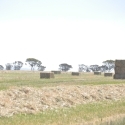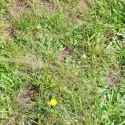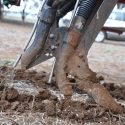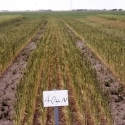Addressing sulphur needs in-crop
Topdressing S in grain crops
Rob Norton, International Plant Nutrition Institute.
Sulphur is one part of a balanced crop nutrition package, but is becoming more of a limiting nutrient in crop production than in the past, for several reasons:
o higher crop yields require more S;
o increased use of high analysis fertilizers containing little of no S;
o reduced amounts of atmospheric S fallout from the sky; and
o reduced soil S reserves from organic matter losses due to mineralization and erosion.
Sulphur deficiency is most likely to occur in light textured and low organic matter soils, and will show up first where canola is grown. Wheat is also likely to respond to applied S if supply levels are low, although it is less responsive than canola.
Soil tests from 2010 show that 72% of cropping samples had S test values (top 10 cm, KCl-40 S) less than 12 ppm which is considered as only marginal for canola. The KCl-40 test measures the level of sulphate-S and a proportion of the mineralizable S. Over half the samples had levels less than 8 ppm. A deep soil S test, down to 60 cm (similar to mineral N) can be a better indicator of S supply than a 10 cm test, but these figures do suggest that S should be considered in any crop nutrition program. Take care though because if there is significant S down the profile, early deficiency symptoms and plant analyses can be misleading in diagnosing S deficiency.
Table 1 Percentage of 2010 soil samples and KCl-40 soil test values (top 10 cm) for Victoria, New South Wales and South Australia (Incitec Pivot Laboratories).
Soil Test Level (mg/kg) | Crop | Pasture |
<8 | 52% | 43% |
8-12 | 20% | 30% |
>12 | 28% | 27% |
Affected canola plants have pale green leaves and showed a pale yellowish inter-veinal mottling and a slight cupping of the younger leaves, unlike N deficiency which shows first in the older leaves. Symptoms of S deficiency become severe during rapid stem elongation before flowering, and affected crops have pale yellow flowers rather than bright yellow.
Based on field experiments in the 1990’s, as well as current work in the Wimmera and Mallee, the typical demand for S for canola is around 40 kg S/ha while cereals require around 20 kg S/ha. The best rate of S to apply is affected by previous cropping history of a field, the level of N fertility, balanced nutrition with phosphorus (P), potassium (K), and other important nutrients, and soil type.
Recovery from S Stress
Time has passed for at-sowing applications of S, but canola and wheat are both able to recover from S – stress when an available form is supplied. The table below is taken from research done in New South Wales where S was applied at various times during the growth of canola on a site that was very low in S. Table 2 shows that even when applied during stem elongation, the topdressed S treatments were similar to the at-sowing treatments.
Table 2 – Effect of timing and rate of S applied to S-deficient canola on seed yield. The zero S treatment yielded 1.03 t/ha and these plots had 80 kg N/ha and 20 kg/ha P at sowing. LSD (p=0.05) =0.43 t/ha (Hocking et al., 1996).
S Applied (kg/ha) | Sowing | Rosette (5-6 leaf) | Buds Visible | Stem Elongation |
10 | 1.73 | 1.62 | 1.56 | 1.41 |
40 | 2.15 | 2.26 | 2.11 | 2.19 |
Diagnosing S deficiency
Plant deficiency symptoms are a reliable guide (see picture) and plant analysis can also be of value. Research in New South Wales and Western Australia indicated that where S content in the whole tops at stem elongation is less than around 0.4%, a response to added S i expected. This critical value does decline as the crop grows, so correct timing and sampling procedure are critical in interpreting these results.
An alternative to tissue testing is to apply a test strip of fertilizer to check for a response. With a sulphate-S source, responses should be seen in around two weeks.
Products to use
There are several products available and for immediate response, a sulphate-S source is required. Some elemental S can be of value, but it needs to be oxidized before the plant can take it up. Granulated ammonium sulphate (21% N, 24% S) can be top-dressed during crop growth and will provide added N as well as sulphate-S. This product can be mixed with urea to provide a higher N analysis if required. Gypsum can also be used but its handling properties make it difficult to spread evenly. Potassium sulphate (18% S) is also an alternative although it can be expensive compared to other S sources.
Fluid sources (such as ammonium thiosulphate 12% N, 26% S) are not recommended for in-crop application due to foliage damage with this product.
For Further Reading
RF Brennan, MDA Bolland (2006) Soil and tissue testing to predict sulphur requirements in south-western Australia. Australian Journal of Experimental Agriculture, 46, 1061-1068.
AJ Good, JS Glendinning (1998) Canola Needs Sulphur, Better Crops International, Vol. 12, No. 2. (see http://anz.ipni.net/articles/ANZ0016-EN)
P Hocking, RM Norton, A Good (1999). “Canola nutrition.”, In Canola in Australia – the first thirty years. (Eds PA Salisbury, TD Potter, G McDonald, AG Green). (Organising Committee for the Tenth International Rapeseed Congress, Canberra). p. 15-22
(http://www.australianoilseeds.com/__data/assets/pdf_file/0013/2704/Chapter_4_-_Canola_Nutrition.pdf)
P J Hocking, A Pinkerton, A Good (1996) Recovery of field-grown canola from sulphur deficiency. Australian Journal of Experimental Agriculture, 36, 79-85.
A Pinkerton, PJ Hocking, A Good, J Sykes, RBD Lefroy, GJ Blair (1993) A preliminary assessment of plant analysis for diagnosing S deficiency in canola. Proceedings of the 9th Australian Research Assembly on Brassicas, Wagga Wagga, New South Wales. P21-28.




